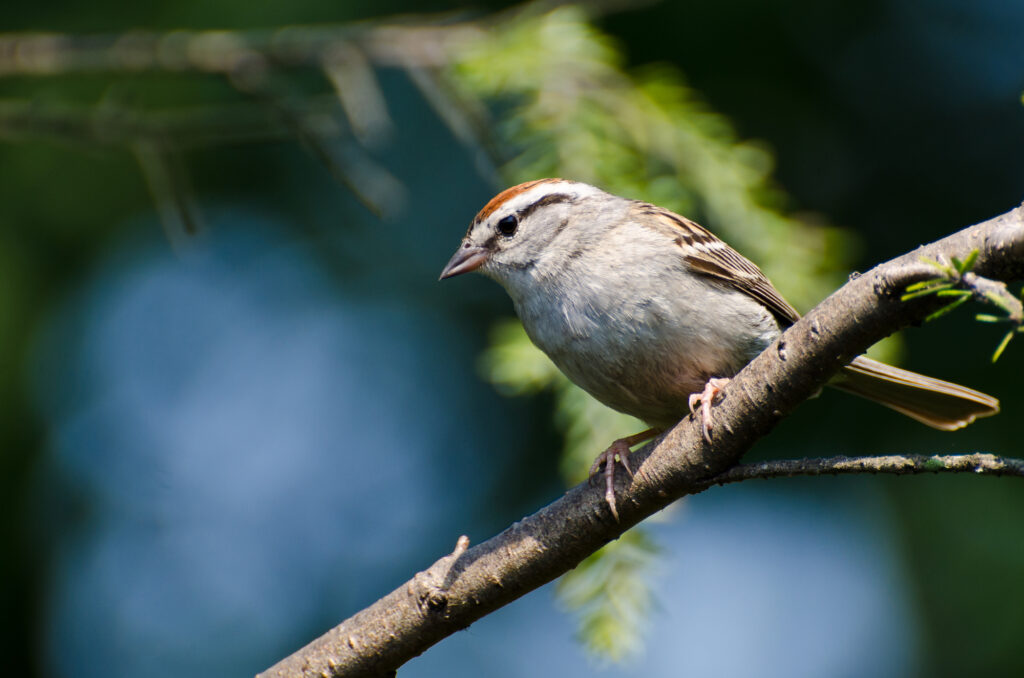Whether you’re a local resident, a casual visitor, or a dedicated nomadic bird watcher, you may be wondering which sparrows you can see in Wisconsin.
But which species you’re likely to encounter will depend a lot on what time of the year you’re looking. Of all 20 sparrows we’ve counted in Wisconsin, most are summer residents only.
With its northerly position and cold winters, it’s hardly surprising that most small birds choose to overwinter in warmer climates.
But there are a few exceptions. A few sparrows remain in Wisconsin throughout the entire year, especially towards the south of the state, and one hardy species can even be found in Wisconsin exclusively in winter – can you guess which one?
Come with us as we explore Wisconsin’s wealth of sparrow species, and offer you our top tips on how to distinguish these little brown birds when you’re out in the field.
Sparrows in Wisconsin, Beginning With the Most Common
Song Sparrow

- Scientific Name: Melospiza melodia
- Length: 4.7-6.7 in (12-17 cm)
- Weight: 0.4-1.9 oz (12-53 g)
- Wingspan: 7.1-9.4 in (18-24 cm)
Song sparrows are the most frequently spotted sparrow in the United States, and also the most commonly spotted in Wisconsin.
Although they’re only found in the southern parts of the state during the winter, they can be found nesting throughout Wisconsin during the spring and summer months.
While their brown, streaky body and rufous-tinted wings may resemble many other members of the family, it’s this sparrow’s constant song that is its most distinguishing feature.
These classic little brown jobs can be seen just about everywhere, but they especially enjoy brushy habitats near water.
House Sparrow

- Scientific Name: Passer domesticus
- Length: 5.9-6.7 in (15-17 cm)
- Weight: 0.9-1.1 oz (27-30 g)
- Wingspan: 7.5-9.8 in (19-25 cm)
Although less common than they once were, house sparrows are the second most common sparrow in the United States. They’re the second most frequently reported in Wisconsin, too.
But did you know that the house sparrow isn’t native to America? They were brought to New York in 1852 by European settlers to control insect pests, their populations exploded and they were soon to be seen across the entire country.
House sparrows belong to a different family to native American sparrows and they also behave differently. Rather than migrating, house sparrows stay in the same territories year-round, typically near human habitation.
Despite their status as an invasive species, this cheerful sparrow is loved by many. They can even be trained to eat out of your hand!
Dark-eyed Junco
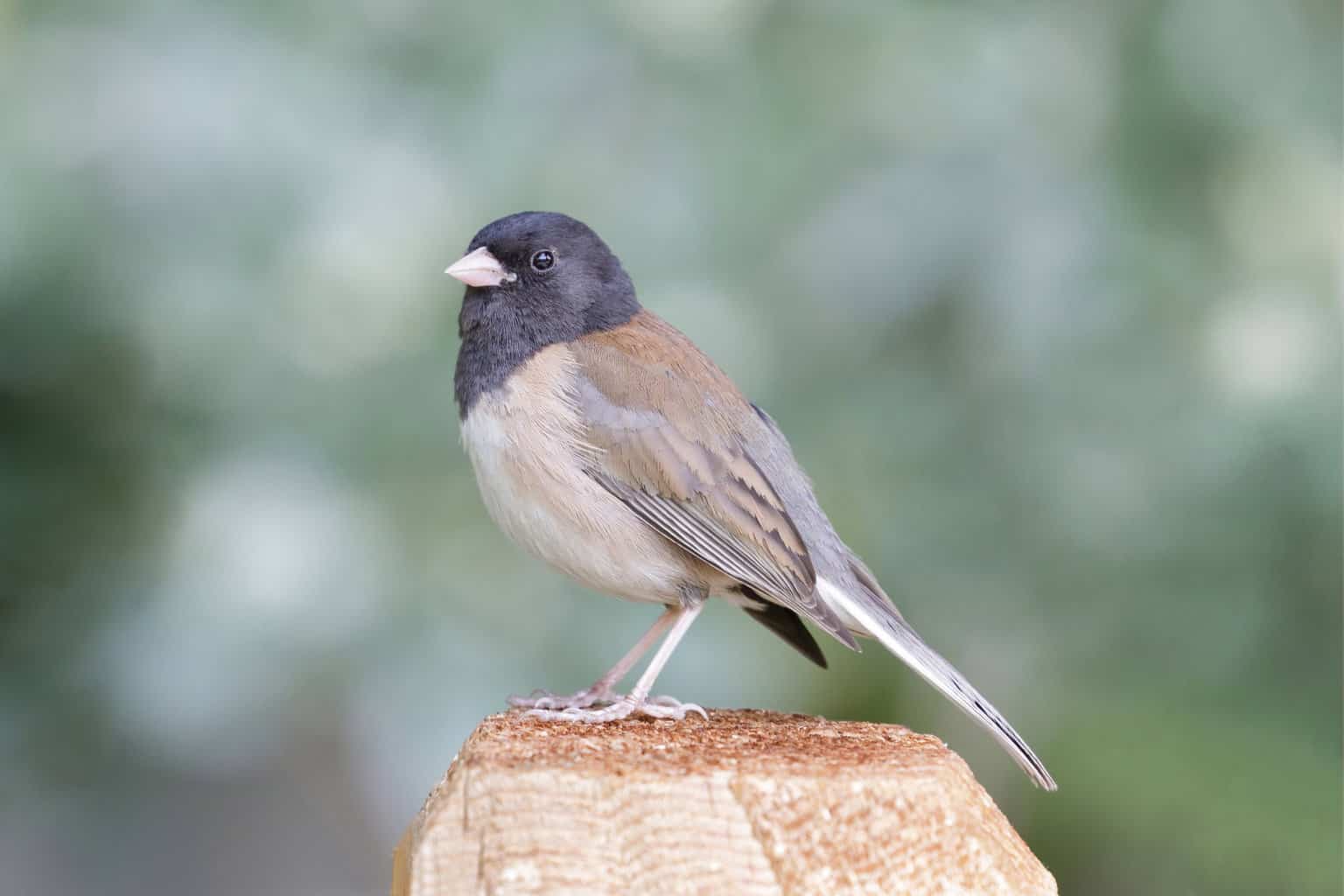
- Scientific Name: Junco hyemalis
- Length: 5.5-6.3 in (14-16 cm)
- Weight: 0.6-1.1 oz (18-30 g)
- Wingspan: 7.1-9.8 in (18-25 cm)
Dark-eyed juncos are fairly large sparrows that have varying plumage depending on which part of America they live in.
In Wisconsin, 99% of them are of the ‘slate-colored’ variety, which perfectly describes the shade of their gray plumage. The reddish-bodied Oregon subspecies is only a very rare vagrant here.
Dark-eyed juncos are famously hardy ‘snowbirds’ and can be found throughout Wisconsin during the winter. This is a great time to attract them to backyard feeding stations by offering them black oil sunflower seeds, and peanuts.
It’s only in the northern parts of the state that you’ll also find them nesting during the spring and summer – usually among open, mature forests.
Chipping Sparrow
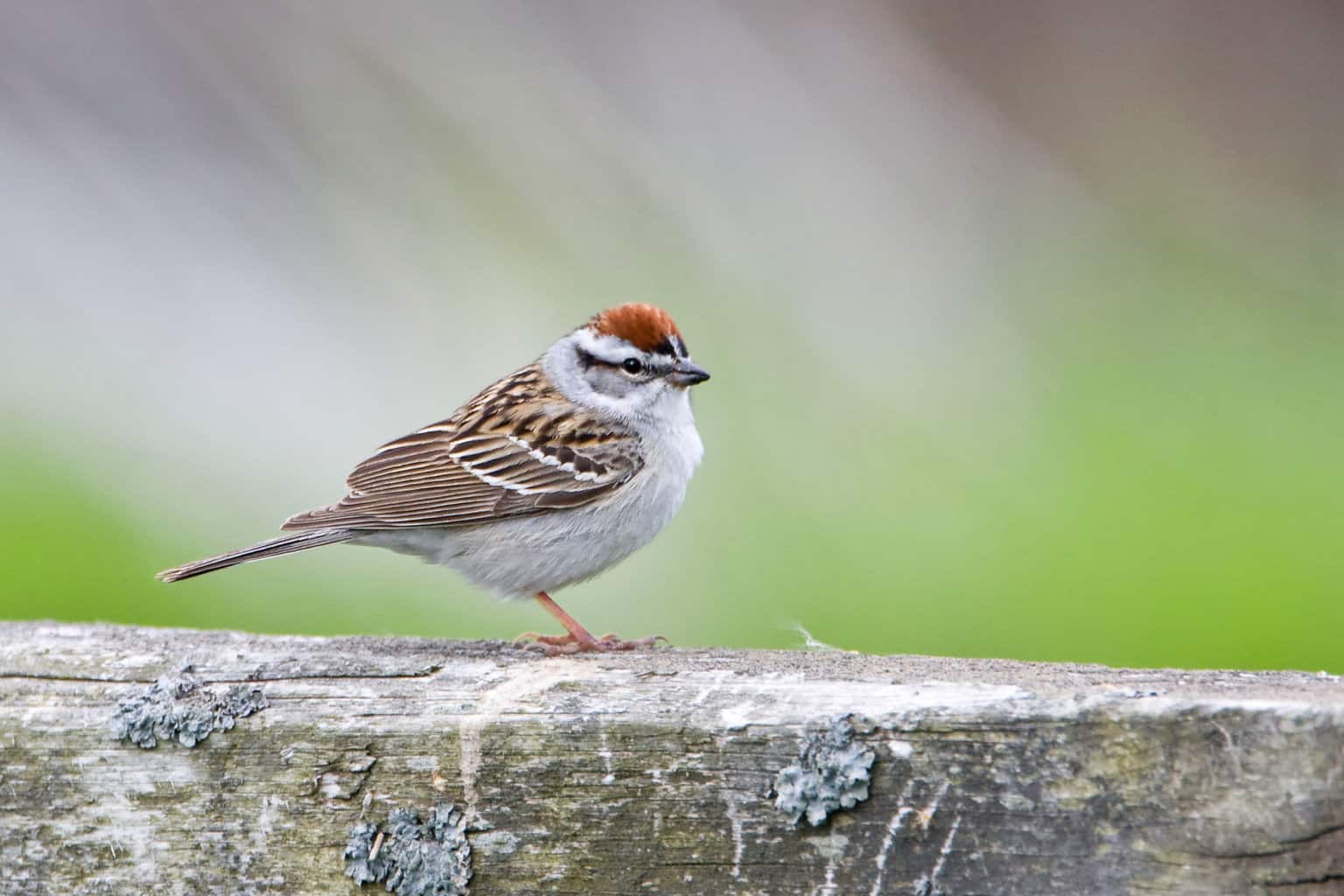
- Scientific Name: Spizella passerina
- Length: 4.7-5.9 in (12-15 cm)
- Weight: 0.4-0.6 oz (11-16 g)
- Wingspan: 8.3 in (21 cm)
Chipping sparrows are named after their noisy ‘chipping’ and trilling – indeed they are one of the most vocal sparrows in North America. They can also be identified visually by the rusty red streak on their head, gray underside, and black eye lines.
These tiny-sized sparrows are widespread throughout most of North America during the breeding season and Wisconsin is no exception. You can find them right through the state, nesting in woodland edges and leafy suburban parks.
By the colder months, they are long gone, back to their wintering habitats in the most southerly states and Central America.
White-throated Sparrow
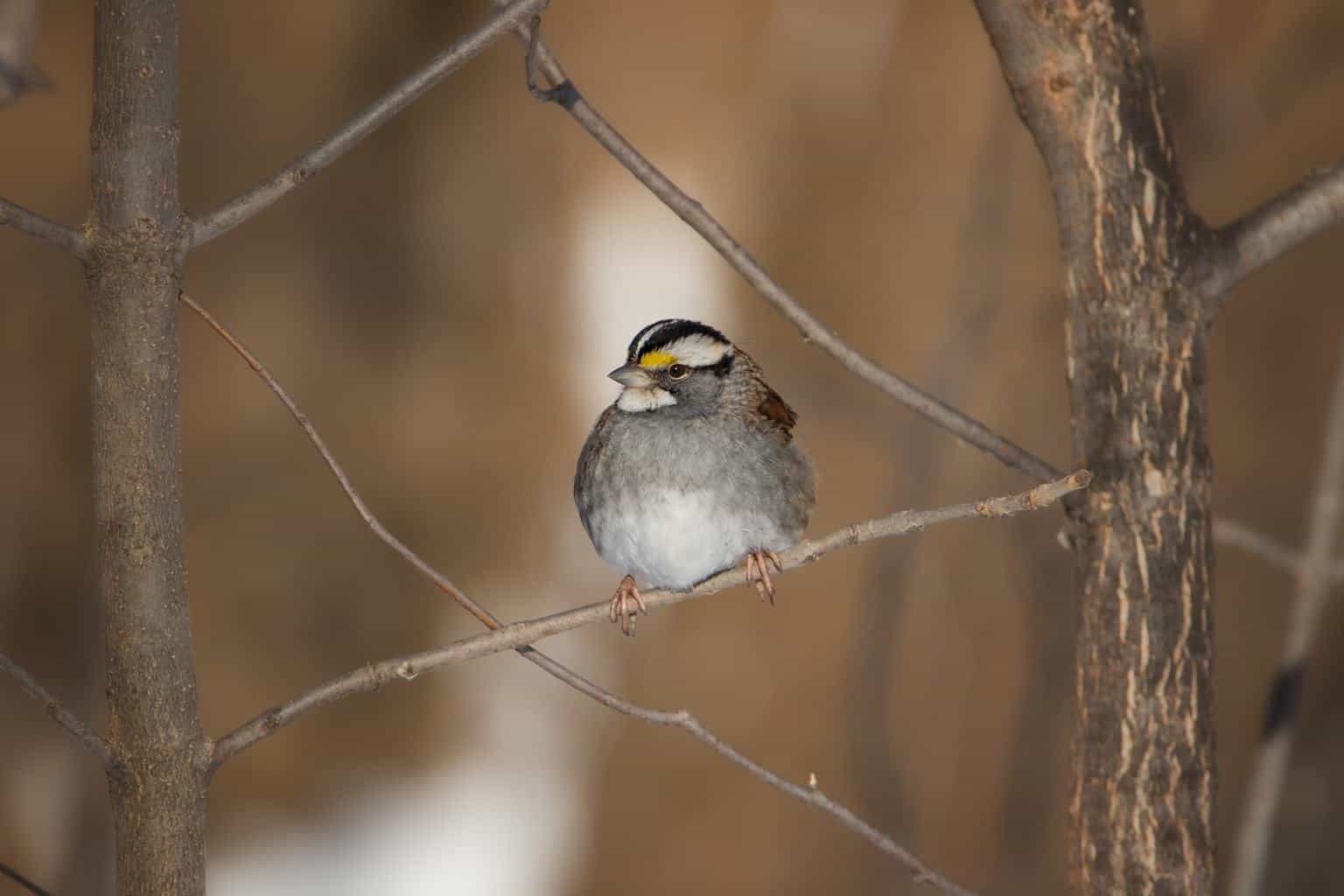
- Scientific Name: Zonotrichia albicollis
- Length: 6.3-7.1 in (16-18 cm)
- Weight: 0.8-1.1 oz (22-32 g)
- Wingspan: 7.9-9.1 in (20-23 cm)
White-throated sparrows are fairly easily recognized by their black and white/tan striped heads and yellow eyebrows. They also have a distinctive, rather mournful whistle that’s sometimes remembered by the mnemonic: Oh Sweet Can-a-daaaa! (…Canada-Canada!).
This also helps us to remember the chief breeding ground of these largish sparrows, although the north of Wisconsin is one of the few nesting strongholds for these birds south of the border. Nests are built by females, on or low to the ground, in dense vegetation.
It’s during the spring and fall migratory seasons, however, that you’ll see the most white-throated sparrows in Wisconsin when large flocks pass to and fro more northerly breeding grounds.
You may spot a few white-throated sparrows in the southern fringes of Wisconsin during winter, too.
American Tree Sparrow
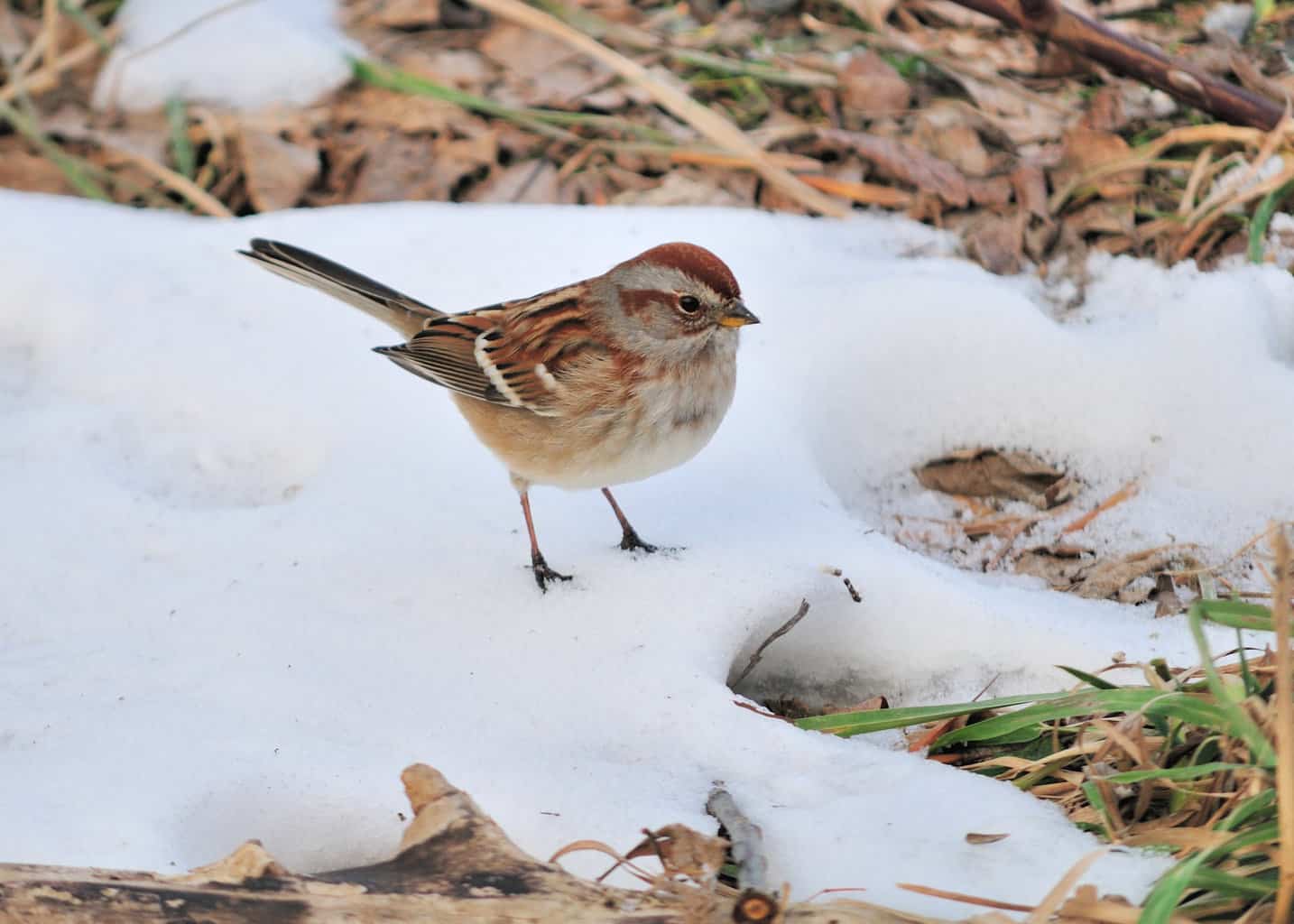
- Scientific Name: Spizelloides arborea
- Length: 5.5 in (14 cm)
- Weight: 0.5-1.0 oz (13-28 g)
- Wingspan: 9.4 in (24 cm)
These medium-large sparrows were named by early European settlers who felt that this bird reminded them of their native tree sparrow. This American species, however, doesn’t frequent trees and is more often found near the ground!
Unbelievably, Wisconsin is merely a wintering ground for American tree sparrows, who have the most northerly range of any sparrow on the continent. They can be found throughout the state during the colder months, except in the northern quarter.
You can help these tough little birds through cold winter weather by offering them millet, cracked corn, and sunflower seeds from your backyard platform feeder.
In summer, American tree sparrows fly north to nest in the tundra of Northern Canada and Alaska. Listen out for their lovely trilling whistles starting in late winter as they prepare for their voyage north.
Eastern Towhee

- Scientific Name: Pipilo erythrophthalmus
- Length: 6.5-8.2 in
- Weight: 1.1-1.9 oz
- Wingspan: 7.9-11.0 in
Towhees are not everyone’s idea of a sparrow, but they are firmly rooted in the New World Sparrow family, just like the others.
Eastern towhees are larger than the other sparrows on our list, though, and are also more colorful. The rusty red flanks and white chest of these beautiful birds stand out in striking contrast to their darker heads and backs, which are black in males and beige in females.
Eastern Towhees are common birds in overgrown backyards, as they love rummaging through thick shrubs and weedy brush. They are basically summer birds throughout Wisconsin, although small populations may also remain all year in the southwestern corner of the state.
They build their nests on the ground in scrubby places, usually hidden among fallen leaves.
Swamp Sparrow
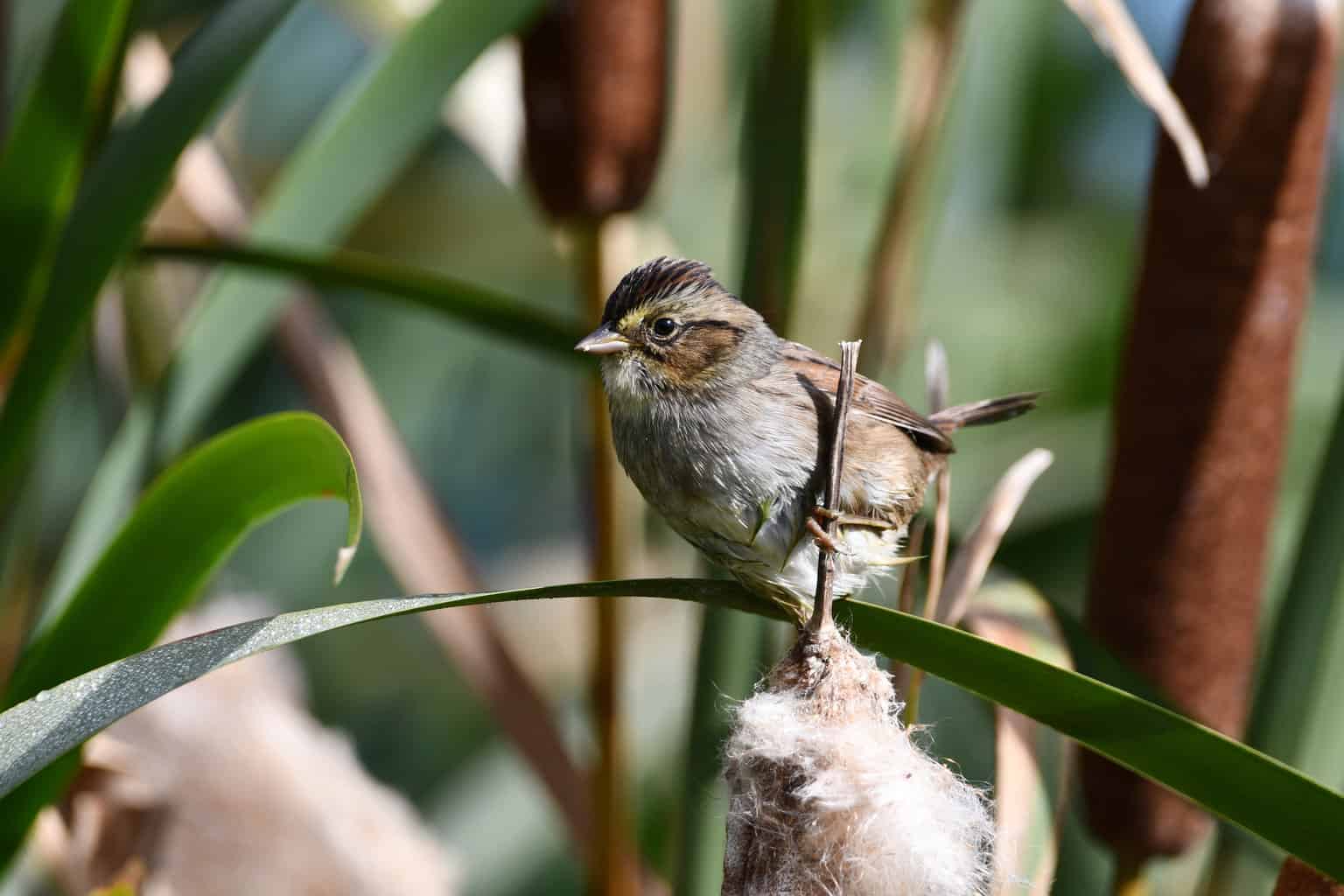
- Scientific Name: Melospiza georgiana
- Length: 4.7-5.9 in (12-15 cm)
- Weight: 0.5-0.8 oz (15-23 g)
- Wingspan: 7.1-7.5 in (18-19 cm)
Since swamp sparrows love water, they’re right at home in the watery landscapes of Wisconsin. They can be found throughout the state in the breeding season, wherever cattails and marshy vegetation offer them a suitable nest site.
The tiny, secretive swamp sparrow is a difficult bird to spot and identify, but their laugh-like, high pitch trill of notes is a good way to locate and recognize them. You can try to attract them to your backyard by offering them a bird bath!
While these cute little birds don’t yet hang about in Wisconsin during the colder months, they can be found in neighboring Illinois throughout the year. Their winter range may, therefore, soon extend into Wisconsin as the climate warms.
Field Sparrow
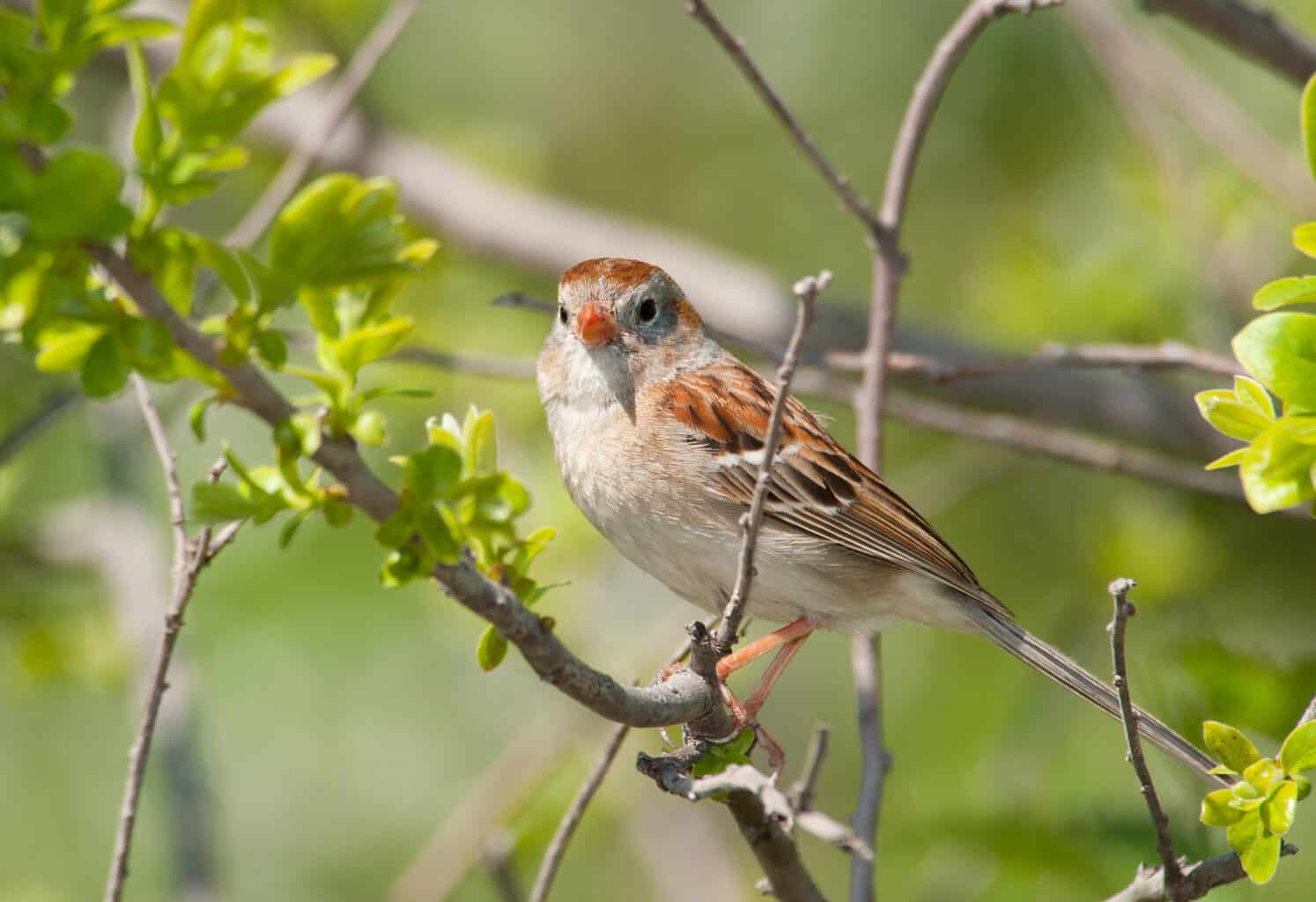
- Scientific Name: Spizella pusilla
- Length: 4.7-5.9 in (12-15 cm)
- Weight: 0.4-0.5 oz (11-15 g)
- Wingspan: 7.9 in (20 cm)
Field sparrows look rather like smaller versions of their cousins the American tree sparrows. As their name suggests, they’re more often found in fields, particularly those with weeds and scattered trees.
The nice thing is, there’s no chance to get these little birds confused with their relatives because whereas American field sparrows only occupy Wisconsin during the winter months, field sparrows are only found here during the summer.
The state marks the northern edge of the field sparrow’s breeding range. They nest on the ground, sitting on up to 5 eggs.
Savannah Sparrow
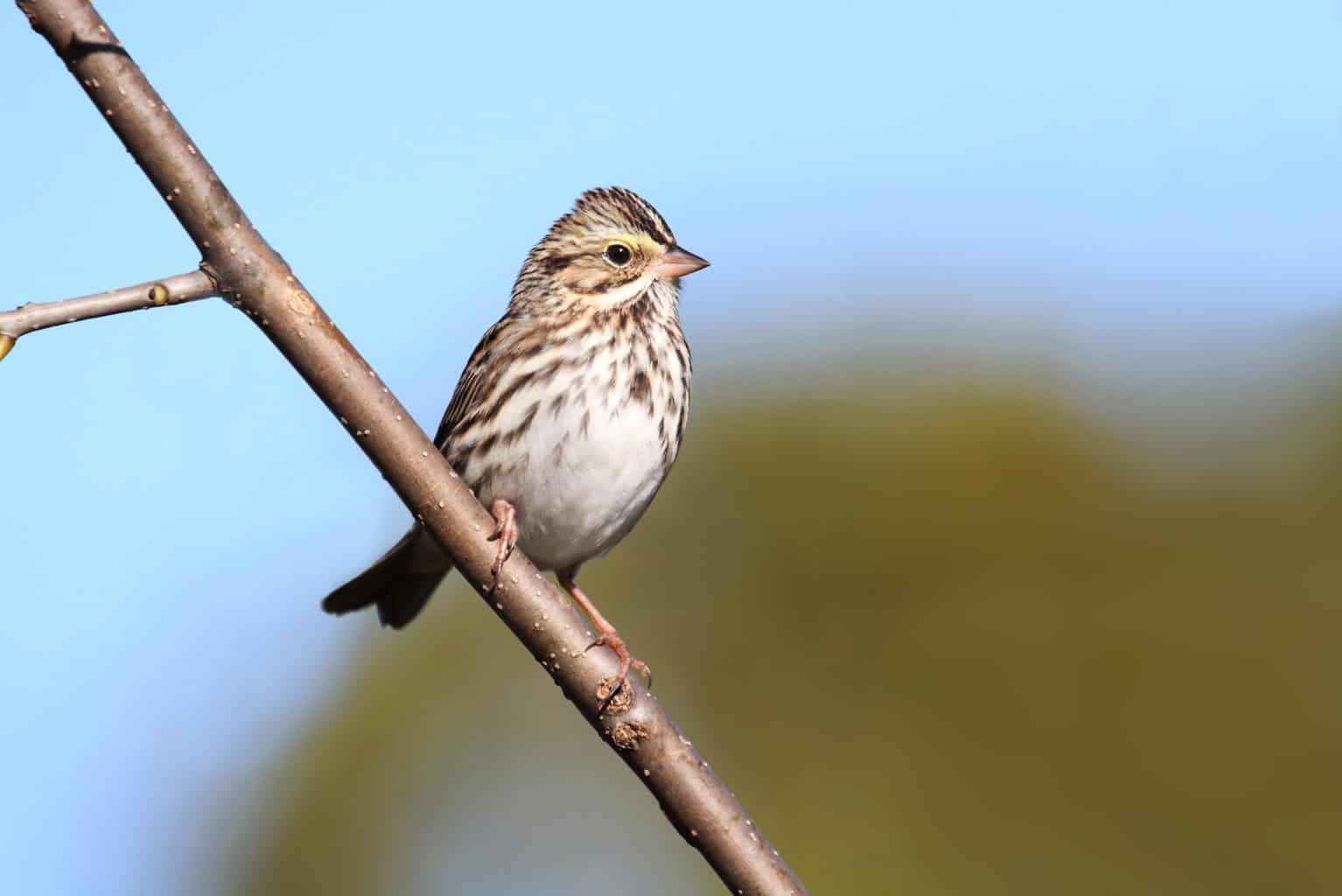
- Scientific Name: Passerculus sandwichensis
- Length: 4.3-5.9 in (11-15 cm)
- Weight: 0.5-1.0 oz (15-28 g)
- Wingspan: 7.9-8.7 in (20-22 cm)
Savannah sparrows are untamed grassland birds that tend to stay away from human habitation. Although they look rather like song sparrows, they can be differentiated with a pair of binoculars by their short tail and yellow wash around their face.
These medium-large sparrows are one of the most common species of open grasslands. You’ll often see them either perched on top of dead weed stems or on fences.
Savannah sparrows are only present in Wisconsin during the breeding season when they can be found throughout the state. They build their nests on the ground out of grass, and their young take between 1-2 weeks to fledge.
White-crowned Sparrow
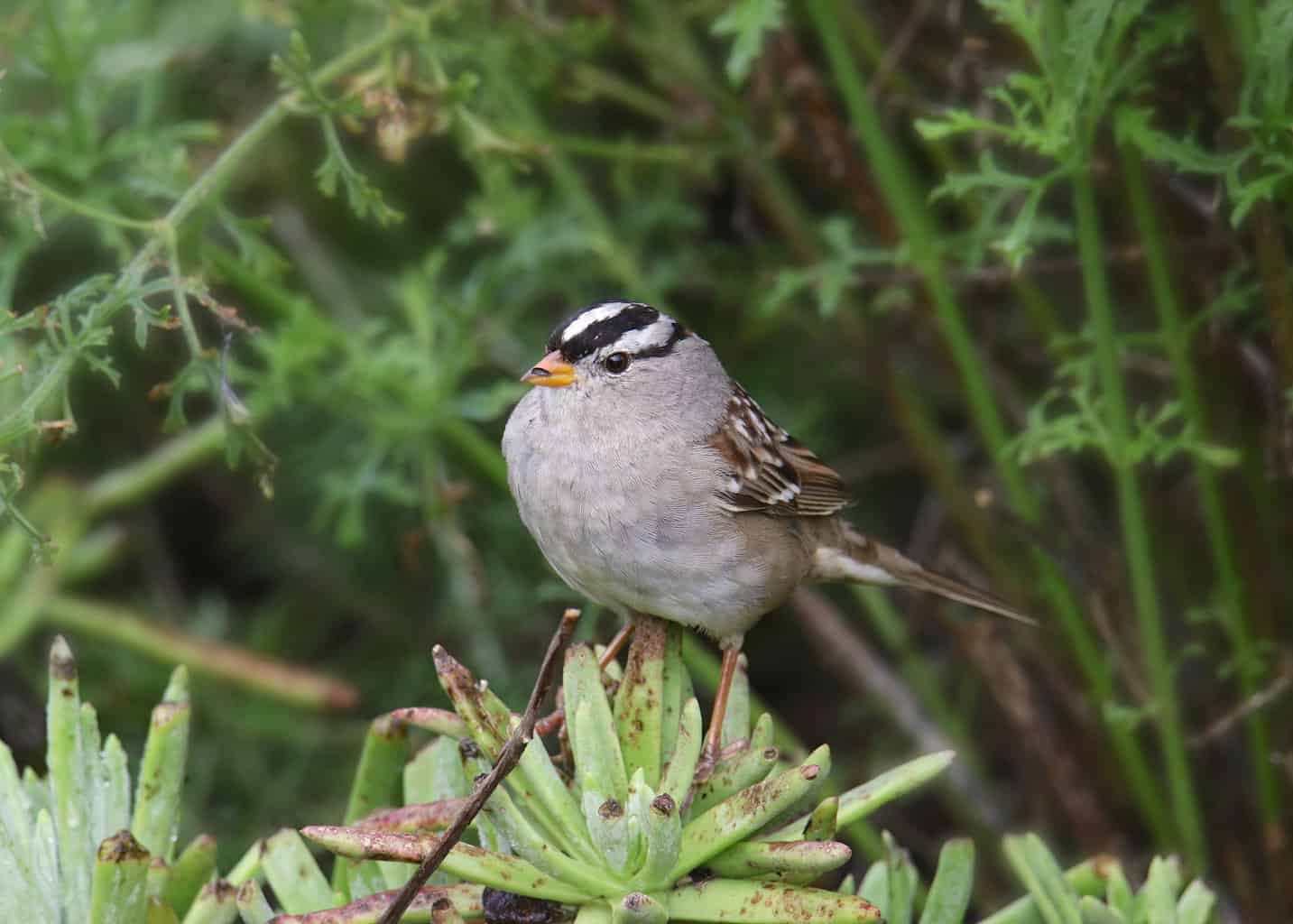
- Scientific Name: Zonotrichia leucophrys
- Length: 5.9-6.3 in (15-16 cm)
- Weight: 0.9-1.0 oz (25-28 g)
- Wingspan: 8.3-9.4 in (21-24 cm)
White-crowned sparrows are fairly large members of the family that are easily recognized by the black and white stripes on their heads and yellowish bills.
This species has a large migratory range and are classified as transient in most of Wisconsin. The southeastern fringes of the state, however, mark the northern boundary of this bird’s winter range, so a few can be spotted in this region during the colder months, too.
You can increase your odds of seeing white-crowned sparrows as they pass over in the fall by offering them cracked corn, millet, and other grains at your backyard feeders.
Fox Sparrow

- Scientific Name: Passerella iliaca
- Length: 5.9-7.5 in (15-19 cm)
- Weight: 0.9-1.6 oz (26-44 g)
- Wingspan: 10.5-11.4 in (26.7-29 cm)
Fox sparrows are a rather unique sparrow – very large, with a speckled chest. You’ll normally find them scratching about in the undergrowth, rather like a towhee or a thrush.
In Wisconsin, it’s the red-tinted ‘Taiga’ subspecies of fox sparrow that you’ll see, but normally only during the migratory season.
While a few sightings have been reported during the winter, fox sparrows are mainly seen here in the spring and fall on their way to and from their northerly breeding grounds that extend into the arctic circle!
Clay-colored Sparrow
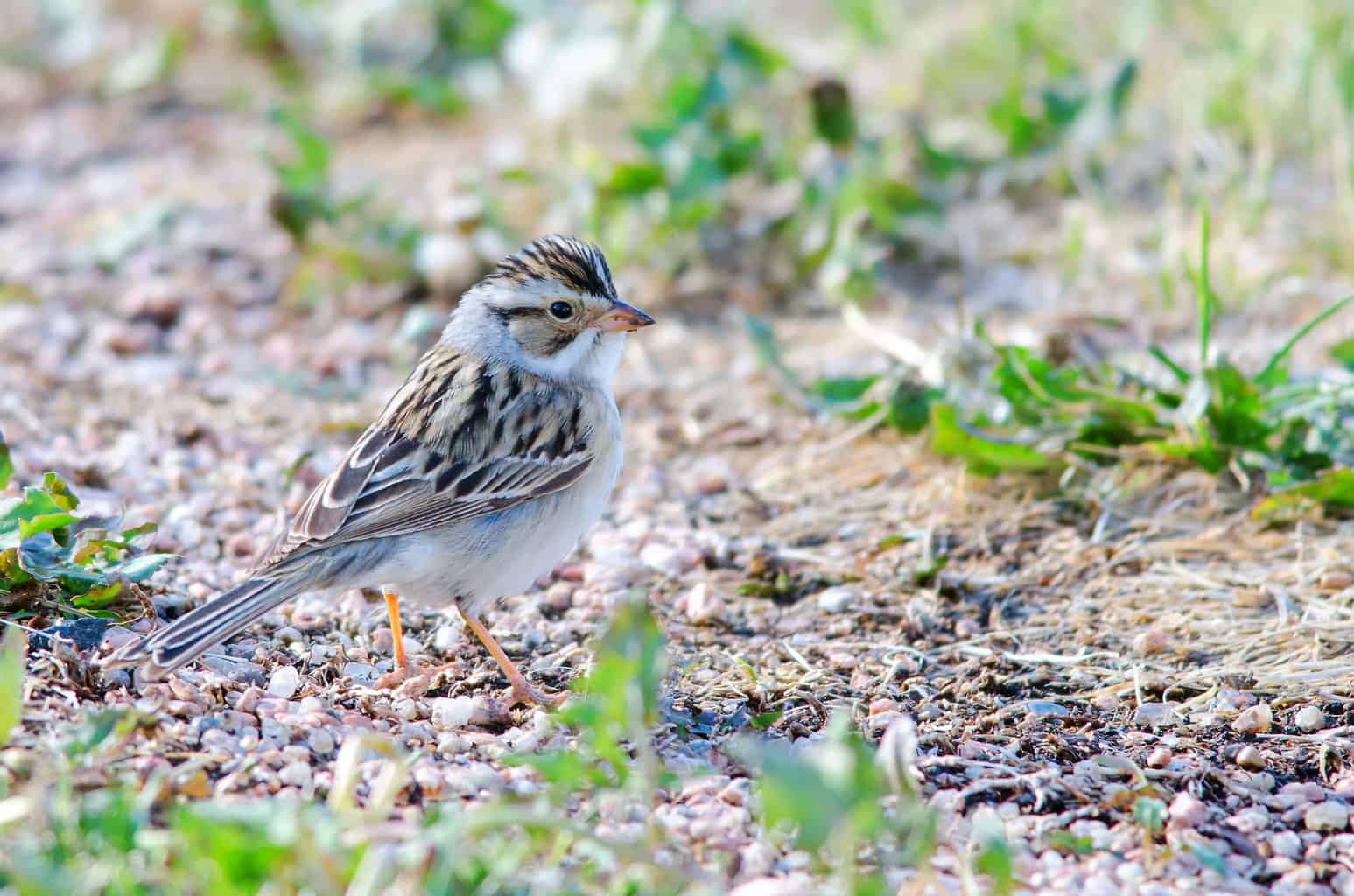
- Scientific Name: Spizella pallida
- Length: 5.1 – 6 in (13 – 15 cm)
- Weight: 0.42 oz (12 g)
- Wingspan: 7.5 in (19 cm)
The clay-colored sparrow mostly spends its winters in Central America and is only a migratory species in the vast majority of the USA.
In Wisconsin, however, they can be found nesting near the ground in the northern half of the state during the summer, too. The young leave the nest before they can fly and simply have to run from danger when threatened!
It’s during the breeding season that the clay-colored sparrow is undeserving of its name! Between April and August, it has a white underside, rather than the pinkish-brown colored underside that defines these birds during the winter.
Still, this white underside is enough to differentiate it from its cousin – the more grayish chipping sparrow.
Lincoln’s Sparrow
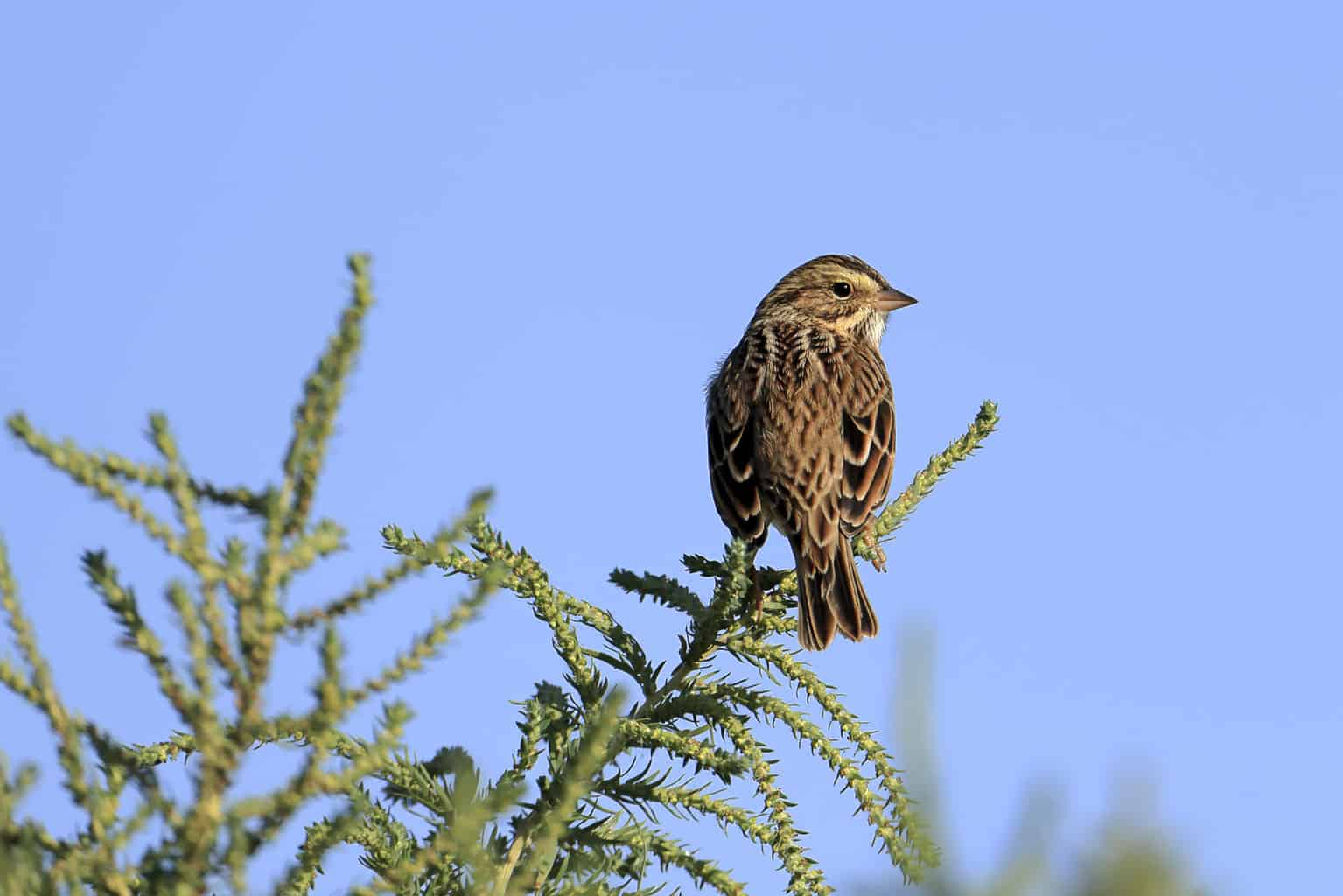
- Scientific Name: Melospiza lincolnii
- Length: 5.1-5.9 in (13-15 cm)
- Weight: 0.6-0.7 oz (17-19 g)
- Wingspan: 7.5-8.7 in (19-22 cm)
Lincoln’s sparrows have declined a lot in recent decades, which is tragic for a bird with such a sweet song! It’s this song which is its most defining characteristic – once learned, you’ll never forget it.
As with the clay-colored sparrow, the north of Wisconsin marks the southern point of Lincoln’s sparrows breeding range. Their favorite nesting habitats are damp brushy areas, such as willow or alder thickets.
If you don’t happen to be in the north of Wisconsin, you can still catch these medium-sized sparrows passing through the state on their spring and autumn migratory routes. Listen out for that song!
Vesper Sparrow
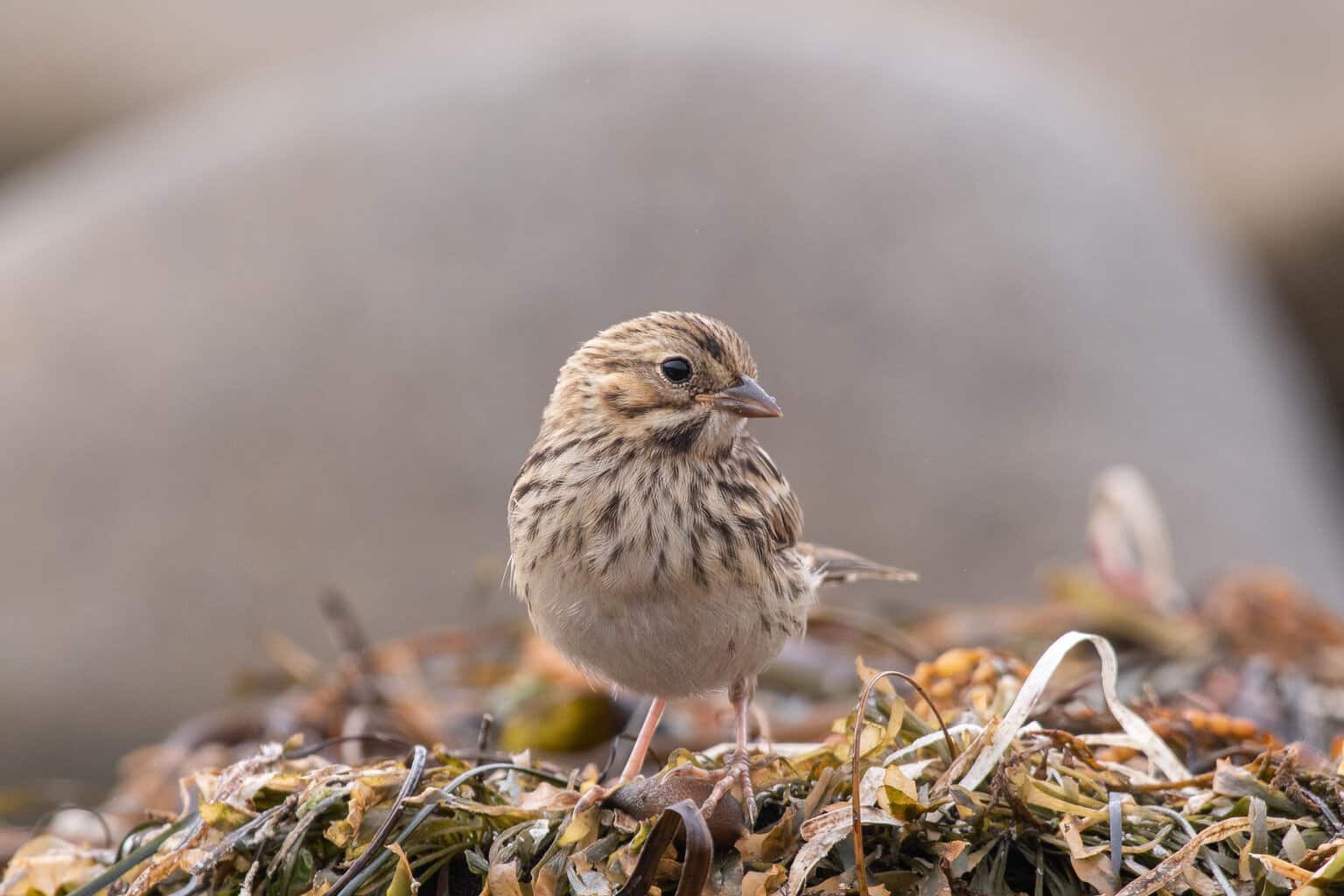
- Scientific Name: Pooecetes gramineus
- Length: 5.1-6.3 in (13-16 cm)
- Weight: 0.7-1.0 oz (20-28 g)
- Wingspan: 9.4 in (24 cm)
Remember the Savannah sparrow? Vesper sparrows tend to behave rather like them. Preferring rural life in extensive grasslands, you’ll often see these birds flying to perch upon the nearest fence or tree branches when disturbed.
They’re larger than Savannah sparrows though, and don’t have the yellow eyebrows or clean white belly of their field mates. Vesper sparrows are never a common sight, and their numbers have been declining across North America.
Modern agricultural practices are thought to be partly to blame for its demise since this sparrow requires grasslands with high biodiversity to thrive. Conservation initiatives will be critical to prevent populations from declining even further.
Grasshopper Sparrow
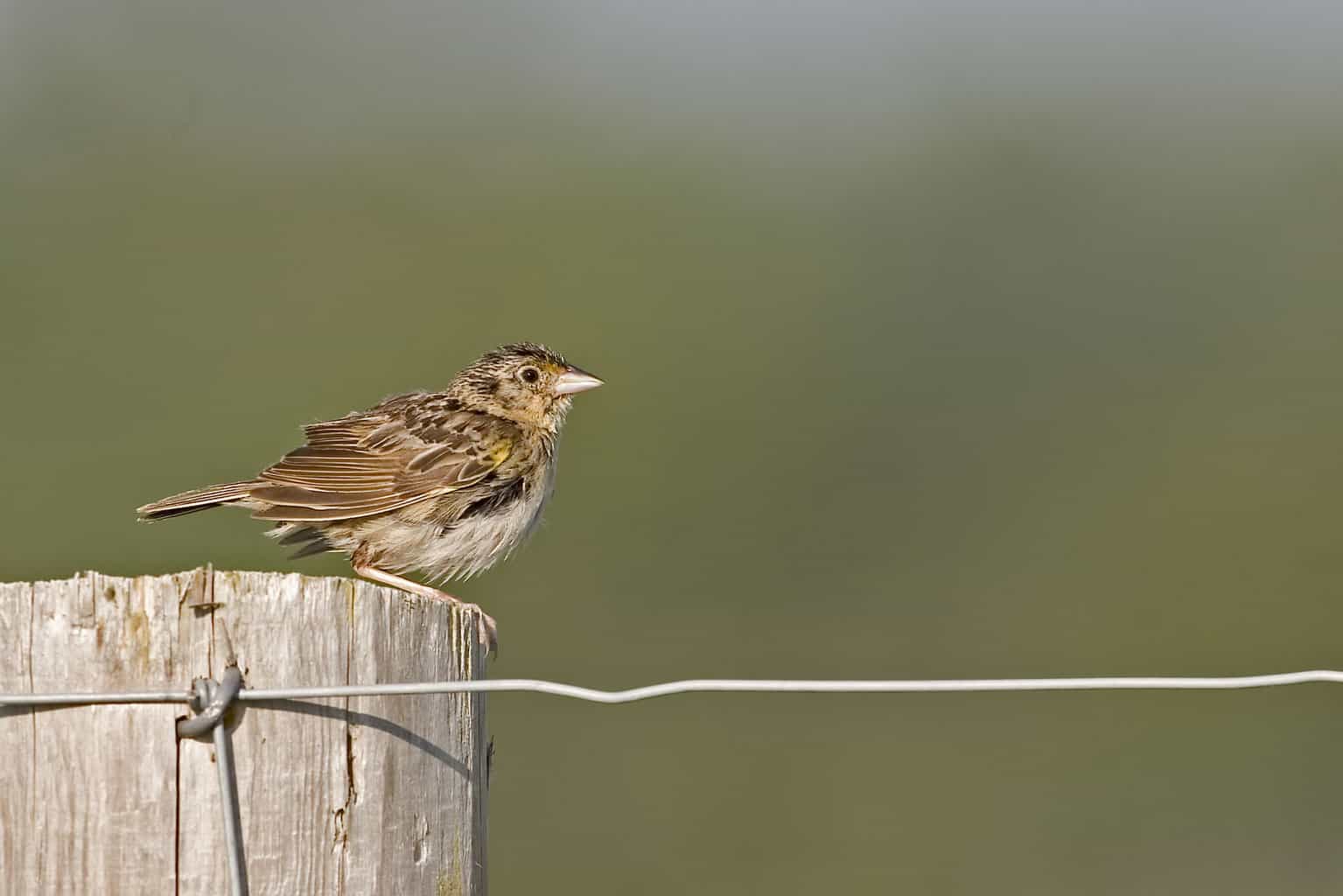
- Scientific Name: Ammodramus savannarum
- Length: 4.3-4.5 in (10.8-11.5 cm)
- Weight: 0.5-0.7 oz (14-20 g)
- Wingspan: 7.9 in (20 cm)
Grasshopper sparrows are tiny, secretive birds of wild grasslands. With a yellowish belly and a large bill, these birds can also be identified by their grasshopper-like song!
Not only do they sound like grasshoppers, but the chirping insects also make up an important part of the grasshopper sparrow’s diet! Adult birds can sometimes be seen shaking them before feeding them to their young.
Grasshopper sparrows are now an uncommon species but can be found nesting in extensive dry grasslands throughout Wisconsin except for the northern tip, in the region near Lake Superior.
Henslow’s Sparrow
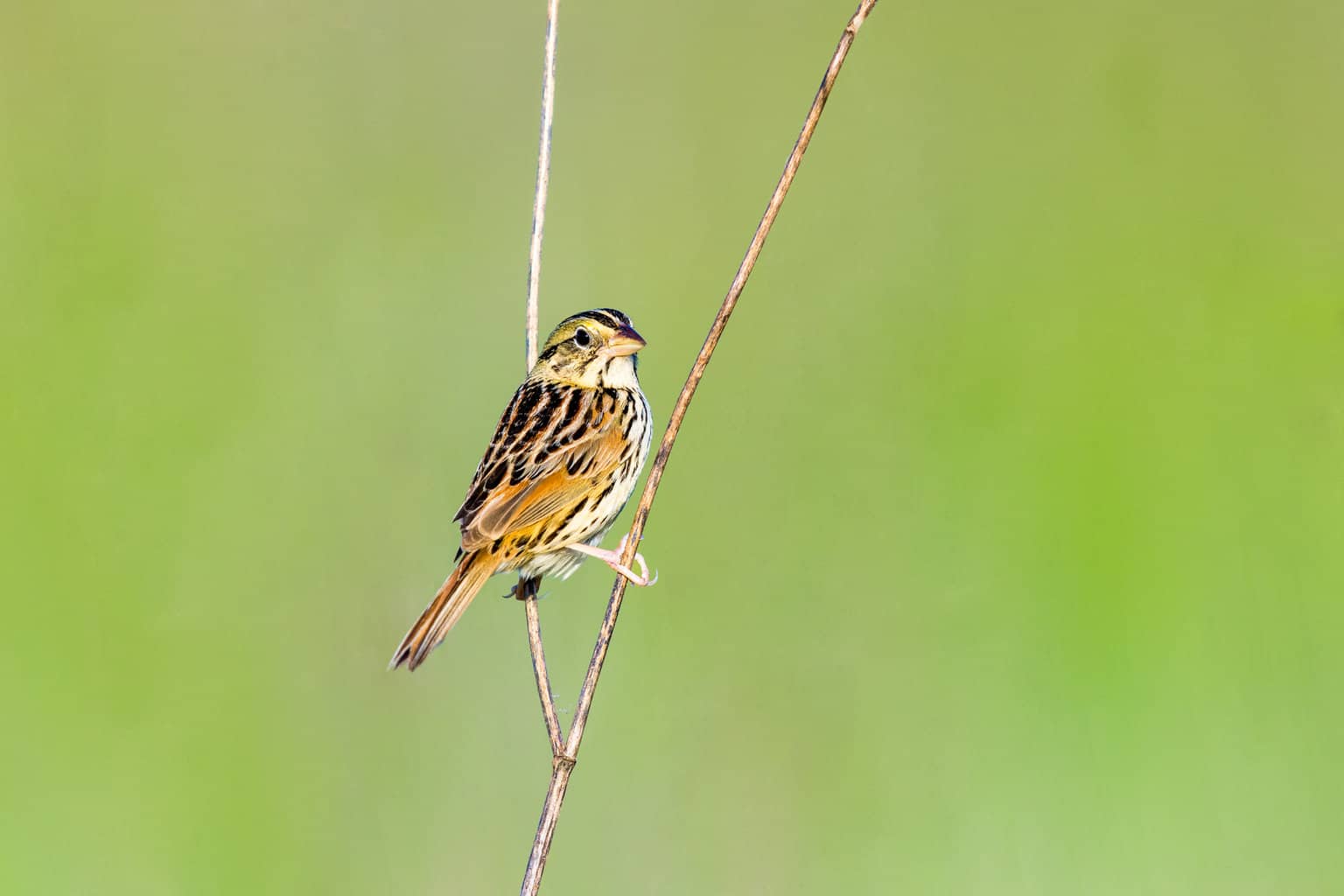
- Scientific Name: Centronyx henslowii
- Length: 4.75 – 5.25 in (12 – 13 cm)
- Weight: 0.5 oz – (14 g)
- Wingspan: 6-7 in – (15 – 18 cm)
An even tinier cousin of the grasshopper sparrow, Henslow’s sparrow is one of the smallest of all sparrows in North America. They can be recognized by their short tail, large yellowish head, and heavy bill.
Henslow’s sparrows are a rare and local species that can only be found in the southern two-thirds of Wisconsin during the breeding season. They spend their winters in the southeastern fringes of the USA.
Since Henslow’s sparrow populations are declining so fast, they should be considered prized spotting. Like its relative, its song sounds like an insect, but they are normally found in wetter habitats than the grasshopper sparrow.
Lark Sparrow
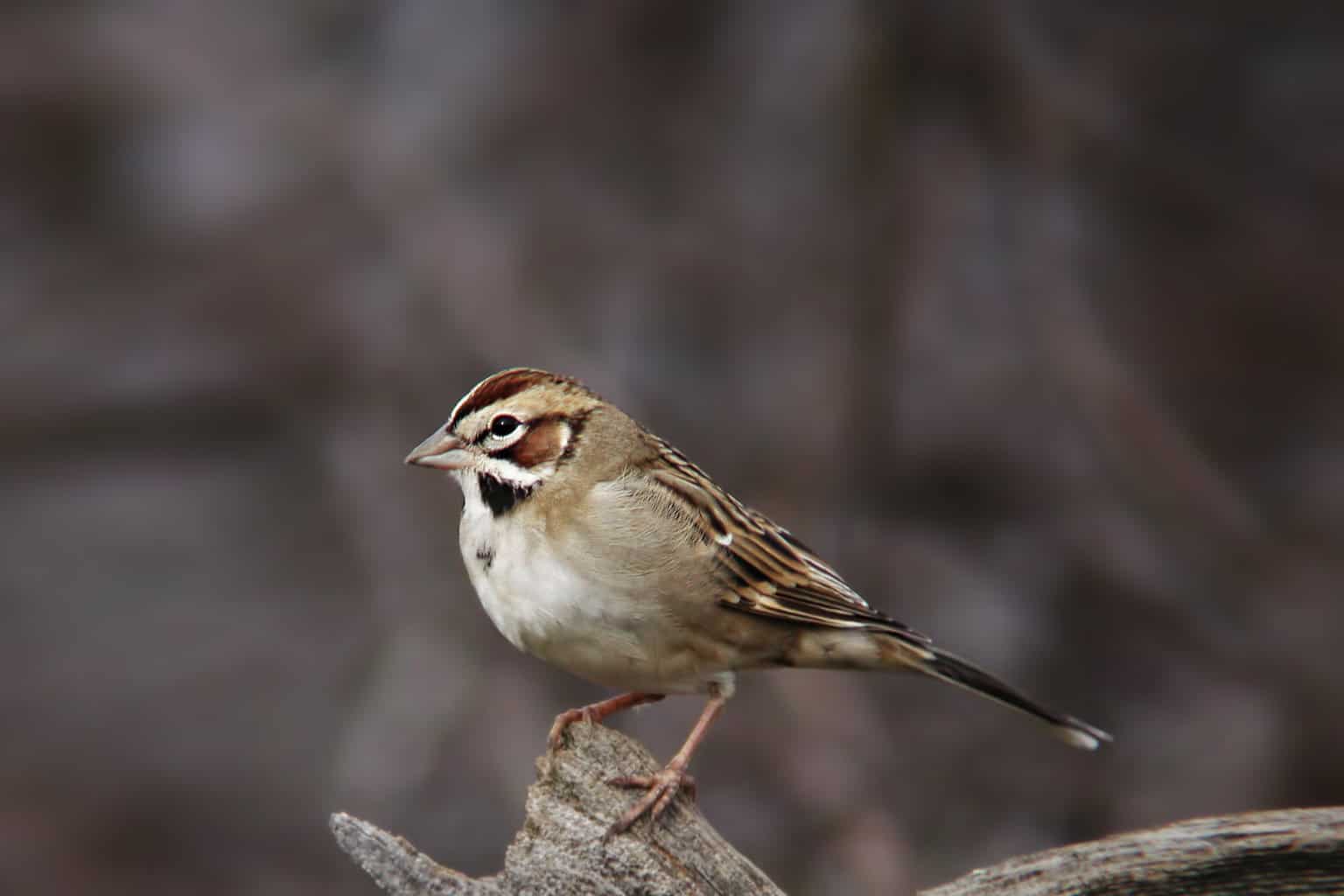
- Scientific Name: Chondestes grammacus
- Length: 5.9-6.7 in (15-17 cm)
- Weight: 0.8-1.2 oz (24-33 g)
- Wingspan: 11.0 in (28 cm)
A very large sparrow of grassland habitats, lark sparrows are most easily recognized by their large size, the bright white underside with a dark spot on their chest, and the white tips on their tail. Closer inspection also reveals distinct black stripes on their face and a tan crown.
Although much more common further west, lark sparrows are a very rare sight in Wisconsin. They only regularly nest in the western edges of the state, although they do like to explore and will occasionally stray all the way to the Atlantic coast!
Dedicated bird watchers may be lucky enough to witness the courtship dance of the male lark sparrow where he hops, struts, and fans his feathers to impress his mate. The display can last for up to 5 minutes!
Harris’s Sparrow
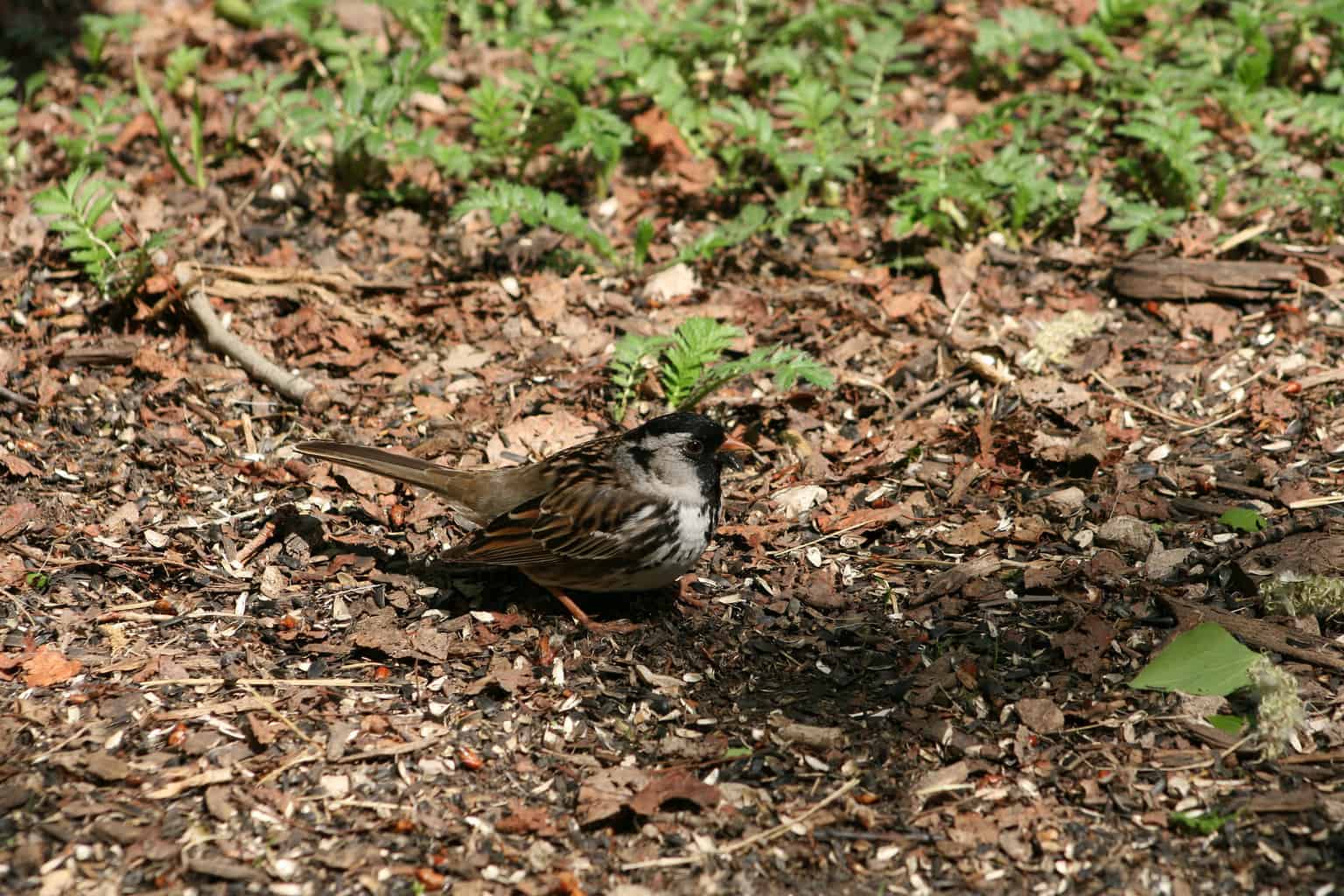
- Scientific Name: Zonotrichia querula
- Length: 6.7-7.9 in (17-20 cm)
- Weight: 0.9-1.7 oz (26-49 g)
- Wingspan: 10.6 in (27 cm)
Apart from the towhees, Harris’s sparrow is the largest of all American sparrows. They’re also one of the most easily recognized, by the black feathers that run from the crown of their heads to the top of their chests.
Although they occasionally wander, Harris’s sparrow typically has a narrow migratory range, from Texas to Central Northern Canada. Wisconsin is a little off their main route, but the west of the state still usually sees a few flocks passing through every spring and fall.
Sadly, Harris’s sparrow is now considered ‘near-threatened’ by the IUCN. Despite there still being around 2 million individuals, Harris’s sparrow decline might be connected with the changing climate and ecology in its northerly breeding grounds.
LeConte’s Sparrow
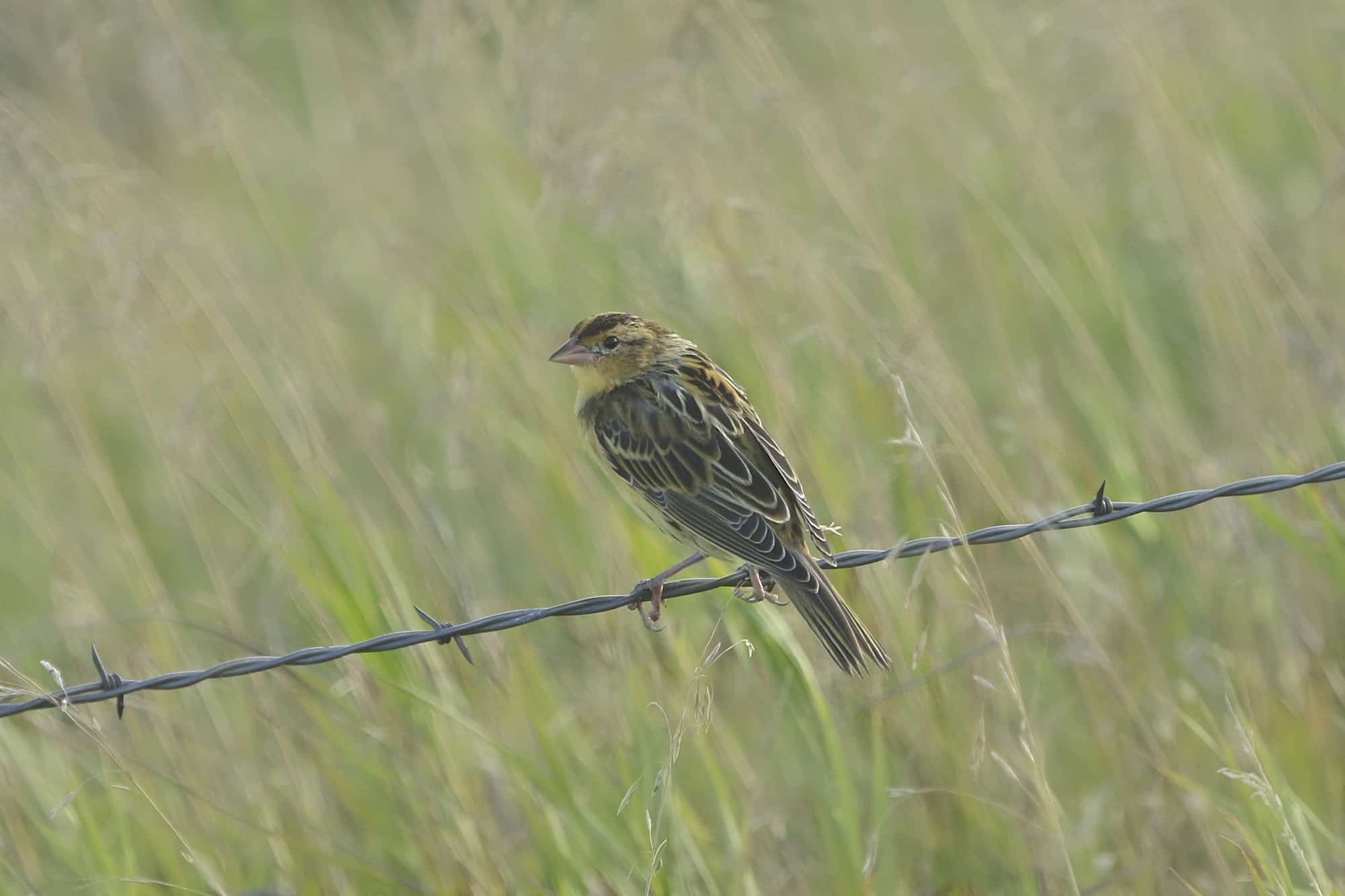
- Scientific Name: Ammospiza leconteii
- Length: 4.7-5.1 in (12-13 cm)
- Weight: 0.4-0.6 oz (12-16.3 g)
- Wingspan: 6.3-7.1 in (16-18 cm)
A close cousin of the grasshopper sparrow, and Henslow’s sparrow, LeConte’s sparrow is another tiny bird of wild, grassy habitats. It can be told apart from its relatives by the crisp, dark streaks on its flanks and its smaller bill.
LeConte’s sparrow has a more northerly range than either of its cousins and is the only one of the three that can only be found nesting in the north of Wisconsin.
Its secretive nature makes it difficult to spot except when it’s singing – a song that sounds more like an insect than a bird! Seen by only one in a thousand bird watchers here, you can go home happy if you managed to spot a LeConte’s sparrow in the field!
Conclusion
We hope you’ve enjoyed our guide to Wisconsin’s sparrows. Whether you’re taming the local house sparrows to eat from your hand, or attempting a sighting of the rare Henslow’s sparrow among damp grassland, the state offers more than enough opportunities to engage with these adorable birds.
There’s a lot more than just sparrows to see in Wisconsin, though! More than 400 birds have been recorded in the state since records began, and we’ve compiled a list of the most iconic of them in our guide to 25 beautiful birds in the Badger State.

